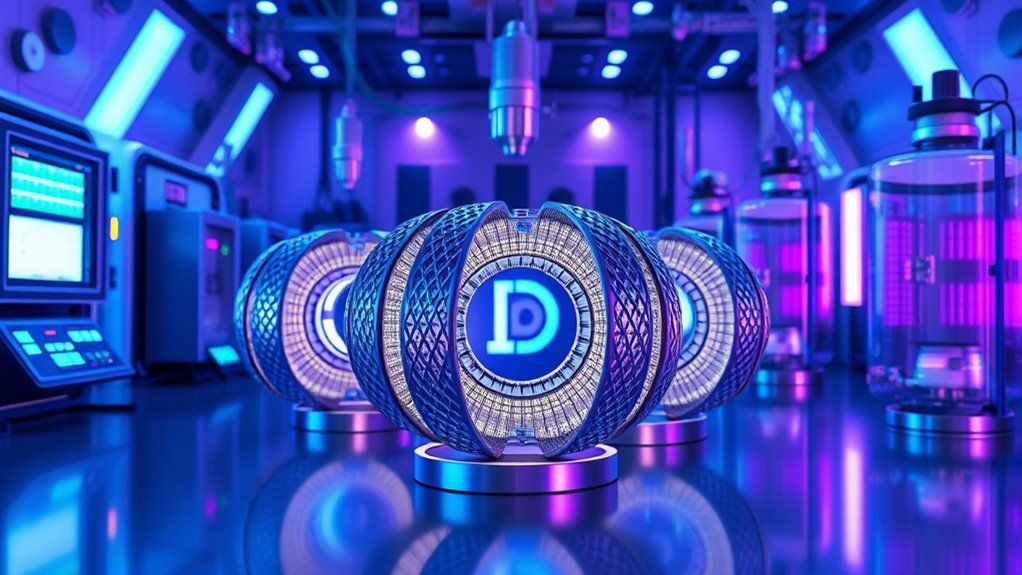Advances in 3D printing are revolutionizing the race to build fusion reactors by allowing you to create complex, durable, and precisely optimized magnets. This technology enables the design of intricate geometries, internal cooling channels, and reinforced structures that withstand extreme conditions. It also reduces manufacturing costs and speeds up development cycles, making fusion more feasible. As this innovative approach continues to evolve, you’ll discover how it’s shaping the future of clean energy solutions.
Key Takeaways
- 3D printing enables complex, customized magnet geometries critical for efficient and durable fusion reactor designs.
- Rapid prototyping and reduced manufacturing costs accelerate development timelines for fusion magnets.
- Advanced internal cooling channels improve magnet longevity under extreme heat and radiation conditions.
- Custom material placement enhances magnetic field performance and structural resilience in fusion environments.
- Adoption of 3D printing fosters innovative magnet solutions, advancing the overall progress toward practical fusion energy.

Advancements in 3D printing technology are revolutionizing the development of fusion reactors by enabling the creation of complex, durable magnets with greater precision. As you explore this cutting-edge field, you’ll notice that the ability to produce highly intricate magnet designs directly impacts both magnet durability and manufacturing costs.
Traditional manufacturing methods often struggle to produce the complex geometries required for ideal magnetic performance, leading to compromises in durability and increased expenses. With 3D printing, you can design and fabricate magnets with highly customized structures, enhancing their resilience under extreme conditions commonly found in fusion reactors.
Traditional methods struggle with complex magnet geometries, but 3D printing enables durable, customized designs for fusion reactors.
Magnet durability is essential because these magnets must withstand intense magnetic fields, high temperatures, and radiation exposure over extended periods. 3D printing allows you to select advanced materials and optimize internal structures, such as incorporating cooling channels or reinforcing lattices that improve lifespan.
This tailored approach means you’re less likely to experience degradation or failure, consequently reducing downtime and maintenance costs. The ability to precisely control material placement during printing results in magnets that aren’t only more durable but also more efficient, as you can minimize material waste and optimize performance parameters.
On the other hand, manufacturing costs are a significant factor in the widespread adoption of 3D-printed magnets for fusion reactors. Initially, additive manufacturing may seem more expensive due to equipment costs and the need for specialized materials. However, you’ll find that as the technology matures, these costs are decreasing.
The reduction in material waste, shorter production times, and the elimination of complex tooling contribute to overall cost savings. Furthermore, 3D printing enables rapid prototyping and iterative design improvements, cutting down the time and expenses associated with traditional manufacturing methods.
In your pursuit of fusion reactor development, you’ll also benefit from the scalability of 3D printing. Small batches or even single prototypes can be produced quickly and economically, allowing for extensive testing and optimization before scaling up.
This flexibility helps manage costs more effectively, especially when experimenting with different magnet configurations or materials. As research advances, you can leverage economies of scale, reducing the per-unit cost of these advanced magnets.
Ultimately, the integration of 3D printing into magnet manufacturing for fusion reactors offers a promising path forward. By enhancing magnet durability and controlling manufacturing costs, you’re setting the stage for more reliable, cost-effective fusion energy solutions.
This technological leap not only accelerates development timelines but also paves the way for more innovative designs that could make fusion power a practical reality sooner than expected. Advanced manufacturing techniques are transforming how magnets are produced, opening new avenues for innovation in fusion technology.
Frequently Asked Questions
How Long Will It Take to Commercialize 3d-Printed Fusion Reactors?
You might wonder how long it’ll take to commercialize 3D-printed fusion reactors. With ongoing advances, expect cost reduction and manufacturing flexibility to accelerate development.
However, significant technical challenges remain, so widespread use could still be a decade or more away.
If research progresses rapidly, early prototypes could emerge within five to ten years, but full commercialization depends on overcoming hurdles related to safety, efficiency, and scale.
What Are the Cost Implications of Using 3d-Printed Magnets?
Using 3D-printed magnets can markedly impact costs by enabling cost reduction and increasing manufacturing flexibility. You’ll benefit from lower material waste and faster production cycles, which cut expenses.
Plus, the ability to customize magnets on-demand reduces the need for extensive tooling and inventory. This streamlined process makes fusion reactor components more affordable, helping accelerate development and commercialization.
Are There Safety Concerns With 3d-Printed Magnet Components?
You should consider that safety concerns with 3D-printed magnet components mainly involve material integrity and manufacturing safety.
If the materials aren’t properly tested, the magnets might fail under high stress or temperature, risking safety.
Additionally, manufacturing safety protocols must be followed to prevent defects or contamination.
Ensuring rigorous quality checks and reliable materials helps mitigate these risks, making 3D-printed magnets safer for critical applications like fusion reactors.
How Do 3d-Printed Magnets Compare to Traditionally Manufactured Ones?
You’ll find that 3D-printed magnets often excel in manufacturing precision, allowing complex designs that traditional methods struggle with. However, their material durability can vary depending on the print process and materials used, sometimes falling short of conventional magnets.
While 3D printing offers customization and rapid production, traditional manufacturing usually guarantees more consistent quality and stronger durability, making it preferable for high-stress applications.
Will This Technology Reduce the Overall Time to Achieve Fusion Energy?
You might wonder if this technology speeds up fusion energy development. Improved magnet durability and printing precision could markedly reduce manufacturing time, allowing quicker testing and deployment.
Conclusion
So, here you are, cheering on 3D-printed magnets as the future of fusion energy, thinking they’ll solve everything. Ironically, it’s these tiny, complex magnets that might hold the key — or cause the whole thing to fall apart. As you chase the dream of limitless power, remember: sometimes, it’s the smallest innovations that have the biggest impact. Who knew that printing magnets could be the twist that finally ignites fusion?










